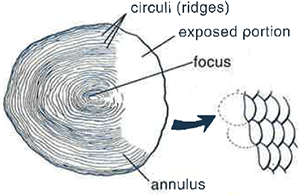Morphology
Last modified on Jan 21, 2021
Scales of teleost fish consist of a mineralized surface layer and a thin, deeper layer of collagenous tissue (Barton 2007). Scales lie in pockets of the dermis and overlap (Figure 1).
The anterior field of the scale is subcutaneous and is the portion of the scale that is studied for fish growth history and age estimation. As a fish grows, material accumulates on the outer margin of this region, and these growth patterns reflect a fish's life history. Age can be estimated by counting the winter growth zones. The posterior field of the scale is exposed to the water and protects the fish. There is usually a silver film over this area that must be cleaned away during scale sampling.
Scales grow incrementally and form concentric ridges (circuli) or patterns of rings, reflecting fish growth rates (Fisher and Pearcy 1990). During periods of fast summer growth, circuli spacing is wider, and during slower winter growth, circuli spacing is narrower. Annual growth, distinguished by pairs of wide and narrow circuli spacing, is counted to estimate fish age (annulus, plural: annuli). The innermost circuli and the original locus of scale formation is called the focus.
See the species identification page to see scale characteristics that can be used to identify species.
References
Barton, M. 2007. Bond's Biology of Fishes, Third Edition. Thomson.
Fisher, J. P., and W. G. Pearcy. 1990. Spacing of scale circuli versus growth rate in young coho salmon. Fishery Bulletin 88(4): 637-643.

